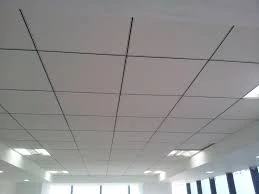- Afrikaans
- Albanian
- Amharic
- Arabic
- Armenian
- Azerbaijani
- Basque
- Belarusian
- Bengali
- Bosnian
- Bulgarian
- Catalan
- Cebuano
- Corsican
- Croatian
- Czech
- Danish
- Dutch
- English
- Esperanto
- Estonian
- French
- German
- Greek
- Hindi
- Indonesian
- irish
- Italian
- Japanese
- Korean
- Lao
- Malay
- Myanmar
- Norwegian
- Norwegian
- Polish
- Portuguese
- Romanian
- Russian
- Serbian
- Spanish
- Swedish
- Thai
- Turkish
- Ukrainian
- Uzbek
- Vietnamese
Th10 . 22, 2024 13:42 Back to list
Suspended Ceiling Tile Framework for Enhanced Interior Design and Acoustics Solutions
Understanding Suspended Ceiling Tile Grids A Comprehensive Guide
Suspended ceiling tile grids have become a popular choice in both residential and commercial construction projects. They offer a practical solution for enhancing aesthetics, acoustics, and building performance. In this article, we will delve into the components, benefits, installation process, and maintenance of suspended ceiling tile grids.
What is a Suspended Ceiling Tile Grid?
A suspended ceiling tile grid, often referred to as a drop ceiling, is an architectural feature that involves hanging a framework of metal grids from the ceiling above. This framework supports lightweight ceiling tiles, which can be made from various materials such as mineral fiber, fiberglass, or metal. The space above the tiles is utilized for routing electrical, plumbing, and HVAC systems, making it not only visually appealing but also functional.
Benefits of Suspended Ceiling Tile Grids
1. Aesthetic Appeal Suspended ceilings can dramatically change the look of a room. With a variety of tile designs and finishes available, from simple white panels to decorative tiles, homeowners and businesses can create a space that reflects their desired ambiance.
2. Acoustic Performance Many suspended ceiling tiles are designed to improve sound quality in a room. They can absorb sound waves, reducing noise pollution and echo, which is particularly beneficial in offices, schools, and restaurants.
3. Easy Maintenance and Access One of the key advantages of a suspended ceiling is that it provides easy access to the space above. This makes maintenance of electrical and HVAC systems straightforward, as tiles can be quickly removed and replaced without disrupting other elements of the ceiling.
4. Energy Efficiency Suspended ceilings can enhance energy efficiency. By incorporating insulation above the tiles, buildings can regulate temperature more effectively, leading to lower heating and cooling costs.
5. Fire Safety Many ceiling tile products are designed to meet fire safety codes. This adds an extra layer of protection for the occupants of a building while ensuring compliance with local regulations.
suspended ceiling tile grid

Installation Process
Installing a suspended ceiling tile grid is a manageable project for both professionals and DIY enthusiasts. However, proper planning and execution are crucial to achieving the best results. Here’s a simplified overview of the installation process
1. Planning Measure the room and plan the layout of the ceiling grid. Mark reference points on the walls to determine the height of the new ceiling.
2. Framing the Grid Use metal channels (tees) to create a framework that will support the tiles. Start by installing the main beams, followed by the cross tees, adhering to the predetermined grid layout.
3. Installing Tiles Once the grid is in place, insert the ceiling tiles into the openings. Ensure that the tiles fit snugly and are level.
4. Final Touches After the installation of the tiles, any necessary finishing touches, such as adding crown molding or repainting the walls, can enhance the overall appearance.
Maintenance of Suspended Ceiling Tile Grids
Maintaining a suspended ceiling is relatively straightforward. Regularly inspect tiles for stains or damage and replace them as necessary. For cleaning, most tiles can simply be wiped down with a damp cloth or sponge. Some tiles are also designed to be washable, making them easy to maintain their appearance.
Conclusion
Suspended ceiling tile grids offer a versatile and functional solution for improving the aesthetics and performance of a space. With their varied designs, acoustic benefits, and easy maintenance, they are an excellent choice for anyone looking to enhance their interior. Whether for a residential home, an office, or a retail space, a suspended ceiling can provide the perfect balance of style and functionality. With careful planning and installation, a suspended ceiling tile grid can transform any room into a masterpiece.
-
Transform Interiors with PVC Gypsum Ceiling: A Stylish, Durable, and Moisture-Resistant SolutionNewsMay.19,2025
-
The Smart Interior Upgrade: Discover the Durability and Versatility of Gypsum Ceiling Access Panel SolutionsNewsMay.19,2025
-
The Smart Choice for Interior Design: Discover the Value of PVC Gypsum Ceiling SolutionsNewsMay.19,2025
-
Mineral Fiber Ceiling Tiles: The Smart Blend of Performance and AestheticsNewsMay.19,2025
-
Mineral Fiber Ceiling Tiles: The Superior Choice Over Gypsum for Sound and Fire SafetyNewsMay.19,2025
-
Mineral Fiber Ceiling Tiles: Eco-Friendly Strength and Style for Every CeilingNewsMay.19,2025







